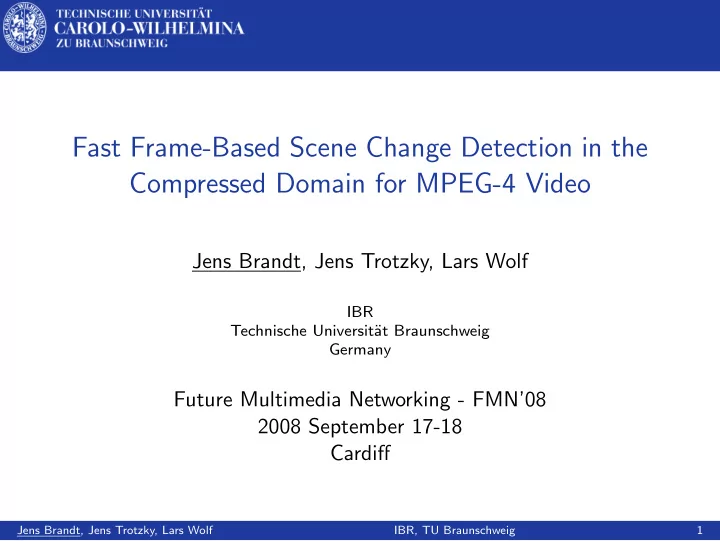

Fast Frame-Based Scene Change Detection in the Compressed Domain for MPEG-4 Video Jens Brandt, Jens Trotzky, Lars Wolf IBR Technische Universit¨ at Braunschweig Germany Future Multimedia Networking - FMN’08 2008 September 17-18 Cardiff Jens Brandt, Jens Trotzky, Lars Wolf IBR, TU Braunschweig 1
Introduction Scope Video adaptation for mobile devices Compressed domain video transcoding Problem How to determine transcoding parameters automatically? Idea Analyse video content in the compressed domain Detect scene changes & special movements Jens Brandt, Jens Trotzky, Lars Wolf IBR, TU Braunschweig 2
Typical Approach Compute differences between successive frames Computed in the pixel domain Based on different mathematical models Find edges Use information about motion Detect scene changes based on the computed differences Our Approach MPEG compressed video already contains such differences Encoded in form of motion vectors and macro block types ⇒ Use these differences to detect scene changes ⇒ Here we concentrate solely on P-frames Jens Brandt, Jens Trotzky, Lars Wolf IBR, TU Braunschweig 3
MPEG-4 Video (Advanced Simple Profile) Frames are divided into 8 × 8 pixel blocks 64 DCT values per block Every set of four blocks builds one macro block (MB) Three different types of macro blocks: inter-coded (with motion information) intra-coded (without motion information) not coded Motion vectors (MV) to encode motion between frames One or four vectors per inter-coded MB Most MV have the same direction as the motion Jens Brandt, Jens Trotzky, Lars Wolf IBR, TU Braunschweig 4
Compressed Domain Frame Analysis Block Based Frame Measures n ¬ 0 Complexity = ratio of non-zero DCT values: c = 64 · n B r INTRA = n MB , INTRA Intra-Ratio = ratio of intra-coded MB: n MB ⇒ this may be a hint about unsuccessful motion estimation MV Based Frame Measure n MV , ¬ 0 Motion Vector Ratio = ratio of non-zero MV: r MV = n MAX , MV ⇒ measure for the amount of motion in the frame Jens Brandt, Jens Trotzky, Lars Wolf IBR, TU Braunschweig 5
Example (Movie Trailer) Jens Brandt, Jens Trotzky, Lars Wolf IBR, TU Braunschweig 6
Example (Movie Trailer) Jens Brandt, Jens Trotzky, Lars Wolf IBR, TU Braunschweig 6
Example (Movie Trailer) Jens Brandt, Jens Trotzky, Lars Wolf IBR, TU Braunschweig 6
Motion Vector Histograms Cartesian: classes Polar coordinate: polar correspond to length and sectors correspond to the direction direction Jens Brandt, Jens Trotzky, Lars Wolf IBR, TU Braunschweig 7
Frame Histogram Four quadrants per frame One histogram per quadrant Includes the origin of the MVs Frame histogram of a zoom Most MVs are pointing outwards Jens Brandt, Jens Trotzky, Lars Wolf IBR, TU Braunschweig 8
Scene Change Characteristics Complexity Intra-Ratio MV-Ratio Cut Fade Zoom Jens Brandt, Jens Trotzky, Lars Wolf IBR, TU Braunschweig 9
Scene Change Characteristics Complexity Intra-Ratio MV-Ratio Cut high very high very high mostly > 0 . 1 mostly > 0 . 5 mostly > 0 . 95 also 0 . 04 > avg > avg Fade Zoom Jens Brandt, Jens Trotzky, Lars Wolf IBR, TU Braunschweig 9
Scene Change Characteristics Complexity Intra-Ratio MV-Ratio Cut high very high very high mostly > 0 . 1 mostly > 0 . 5 mostly > 0 . 95 also 0 . 04 > avg > avg Fade medium medium high mostly > 0 . 15 mostly > 0 . 8 > avg Zoom Jens Brandt, Jens Trotzky, Lars Wolf IBR, TU Braunschweig 9
Scene Change Characteristics Complexity Intra-Ratio MV-Ratio Cut high very high very high mostly > 0 . 1 mostly > 0 . 5 mostly > 0 . 95 also 0 . 04 > avg > avg Fade medium medium high mostly > 0 . 15 mostly > 0 . 8 > avg Zoom similar to the situation of fades Jens Brandt, Jens Trotzky, Lars Wolf IBR, TU Braunschweig 9
Zoom Detection Complexity, Intra-Ratio and MV Ratio similar to fades MVs are pointing inwards or outwards Use histograms to count such MVs A Zoom is detected if Number of zoom indicative vectors is 30% higher than expected for both types of histograms, or Number of zoom indicative vectors is 100% higher than expected for one type of histograms Jens Brandt, Jens Trotzky, Lars Wolf IBR, TU Braunschweig 10
Implementation & Evaluation Implementation Integrated into our transcoder implementation Transcoding module which analyses each frame Evaluation 2 movie trailers, 1 news sequence and 1 soccer game sequence Duration of 90 seconds Resolution between 320 × 240 and 1280 × 720 pixels Encoded with modified FFmpeg (only P-frames) Jens Brandt, Jens Trotzky, Lars Wolf IBR, TU Braunschweig 11
Evaluation Reference Manual frame by frame analysis Cuts consists of exactly one frame Fades and zooms last at least two frames Results Video Cut Fade Zoom existing/detected/false positives news 14/13/2 1/1/2 2/2/0 soccer 4/4/1 5/5/3 9/7/0 movie-1 51/48/1 8/7/4 3/3/0 movie-2 49/38/11 14/13/2 7/7/0 Jens Brandt, Jens Trotzky, Lars Wolf IBR, TU Braunschweig 12
Evaluation (cont.) Most falsely detected frames belong to another type of scene change: Falsely detected cuts belong to fast fades Undetected cuts are detected as single frame fades Moving background is detected as a fade Changing background color is detected as a cut Average processing time per frame: 0.6 to 6.5 ms 18% to 33% of time needed for bit stream parsing ⇒ Very low overhead Jens Brandt, Jens Trotzky, Lars Wolf IBR, TU Braunschweig 13
Conclusion Frame-based compressed domain scene change detection Analysis of DCT values and motion vectors of MPEG-4 video Three different measures Motion vector histograms Easy and fast computation Promising evaluation results Lessons Learned Detecting the type of scene change can be hard Some situations are challenging even for humans Abruptly changing light conditions (e.g. flashlights) Many distributed fine movements (e.g. bubbles in water) Close-ups with moving background Jens Brandt, Jens Trotzky, Lars Wolf IBR, TU Braunschweig 14
Questions? Jens Brandt, Jens Trotzky, Lars Wolf { brandt|trotzky|wolf } @ibr.cs.tu-bs.de IBR Technische Universit¨ at Braunschweig Germany http://www.ibr.cs.tu-bs.de Jens Brandt, Jens Trotzky, Lars Wolf IBR, TU Braunschweig 15
Recommend
More recommend